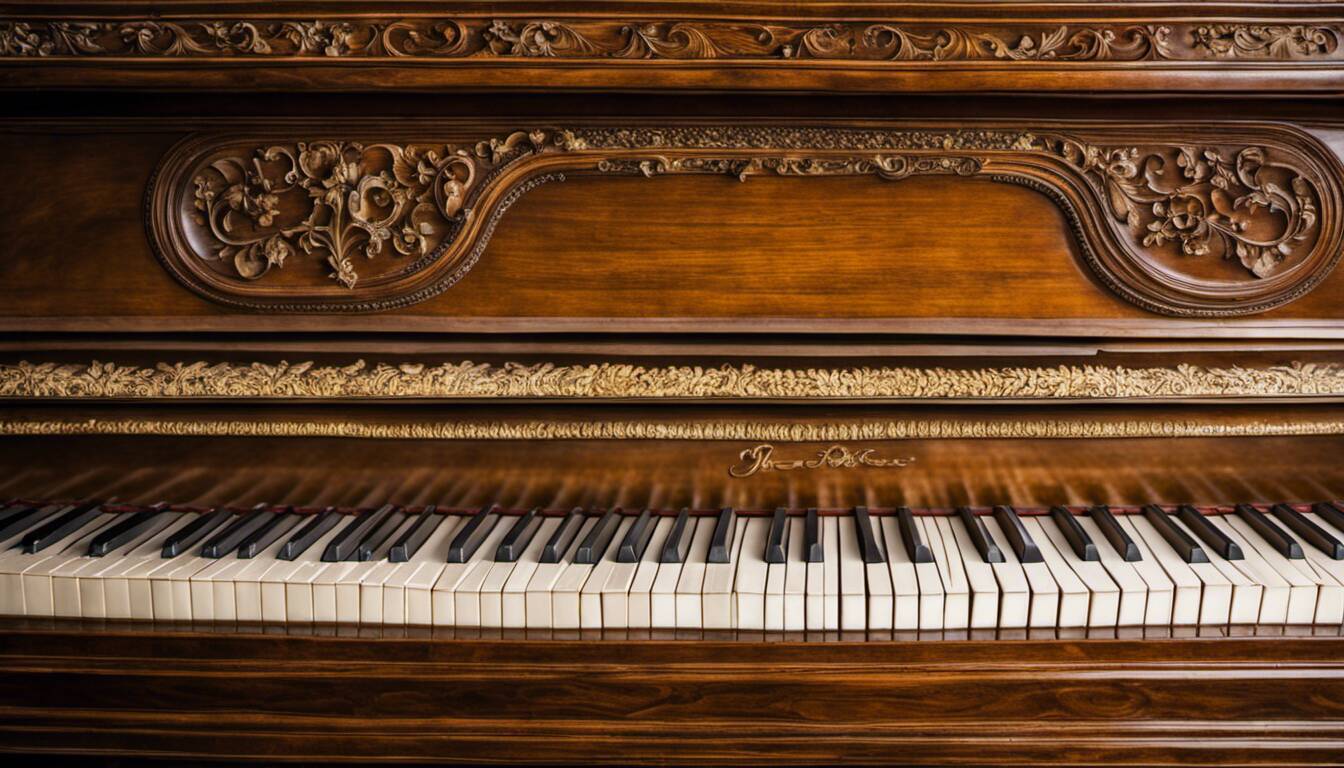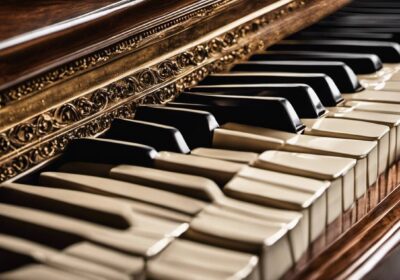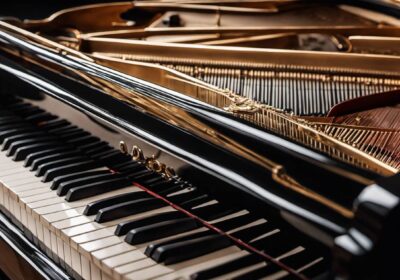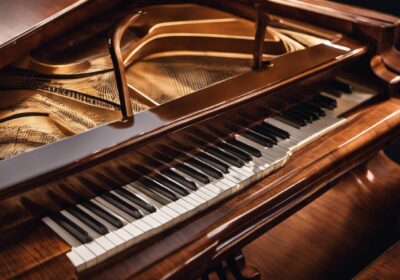Dive into a captivating exploration of sound and symphony as we journey through the echoes of time to trace the evolution of one of the most compelling musical instruments – the piano. Borrowing notes from the annals of history, we invite you on an enlightening voyage to discover how this magnificent—and sometimes underrated—musical marvel morphed over centuries into the instrument par excellence. From its origins amid the Renaissance courts to its key role in 21th-century music creation, join us on this chronicle of how the piano struck chords across eras and continents. Prepare for an enriching symphonic pilgrimage!
The piano has a rich history dating back to the early 18th century, when it was first invented by Bartolomeo Cristofori in Italy. Since then, it has undergone numerous changes and innovations, leading to the modern-day instruments we have today. Our comprehensive guide covers the evolution of the piano from its earliest days through to modern times, highlighting key innovators in its development and notable pieces of music composed for the instrument along the way.
The Development of the Piano
The piano, as we know it today, has a rich and fascinating history that spans several centuries. Its development can be traced back to the early 18th century, when a revolutionary instrument called the pianoforte emerged. This instrument was unlike anything that had come before it, offering musicians a greater range of dynamics and expressive capabilities.
One of the key factors that contributed to the development of the piano was the desire to create an instrument that could produce both soft and loud sounds. The harpsichord, which was widely used at the time, had limited dynamic range and could only produce a fixed volume for each note.
Imagine being a composer or performer during this time, yearning for an instrument that could capture the full spectrum of emotions in their music – from gentle whispers to thundering crescendos. It was this quest for expressive power that ultimately led to the birth of the piano.
Transition From the Harpsichord
Picture yourself in a grand hall filled with elegant music, where a harpsichord is delicately played. The sound is beautiful, but lacks variety and nuance. Now imagine that same hall transformed as a new instrument takes center stage – the piano. Suddenly, notes can be struck with varying degrees of force, opening up an entire world of musical possibilities.
During the transition from the harpsichord to the piano, one major breakthrough was the use of hammers instead of plucking mechanisms. While harpsichords relied on plucking strings with plectra, pianos introduced small hammers that struck strings when keys were pressed down. This innovation allowed for greater control over volume and tone and paved the way for more expressive performances.
Another significant advancement during this transition was the introduction of escapement mechanisms. These mechanisms enabled quick repetition of notes by allowing keys to be released without fully returning to their original position. The invention of the escapement allowed for faster and more virtuosic playing, contributing to the piano’s rise in popularity.
With the transition from the harpsichord to the piano, musicians were now able to explore a whole new world of artistic expression. The piano’s versatility, dynamic range, and responsiveness captivated composers and performers alike, forever changing the landscape of music.
- The piano was invented in Florence, Italy around 1700 by Bartolomeo Cristofori, a craftsman who repaired harpsichords.
- A 2019 survey by Statista showed that approximately 11.02 million American households own a piano, reflecting its continuing popularity since its invention centuries ago.
- According to Kids Play Piano Method (2023), teaching children to play the piano improves their mathematical abilities by 20% compared to non-practicing children.
- The transition from the harpsichord to the piano, marked by the use of hammers and escapement mechanisms, allowed for greater control over volume, tone, and speed. This innovation paved the way for a whole new world of artistic expression, giving rise to the popularity and versatility of the piano.
Inception of Mechanical Design
The history of the piano dates back to the early 18th century when a significant breakthrough in mechanical design led to the creation of this remarkable musical instrument. The predecessor of the piano, known as the harpsichord, had limited expressive capabilities due to its plucking mechanism. However, Bartolomeo Cristofori, an Italian instrument maker, revolutionized keyboard instruments by inventing what we now know as the piano. His innovative mechanical design allowed for a hammer to strike the strings when a key was pressed, producing both soft and loud sounds depending on the force applied. This invention marked a turning point in musical history as it introduced a level of expressiveness previously unachievable.
With the inception of this groundbreaking mechanism, the creation and evolution of pianos gradually made their way across Europe.
The First Pianos in Europe
Following Cristofori’s invention in Italy, the first pianos began making their appearance in various European countries during the second half of the 18th century. Germany became an important hub for piano production, with notable names like Johann Andreas Stein and Gottfried Silbermann contributing significantly to its development. Stein, in particular, improved upon Cristofori’s original design by incorporating advancements such as a more robust frame and improved escapement mechanism.
Interestingly, Wolfgang Amadeus Mozart played a vital role in popularizing these early pianos. During his tours across Europe, he came into contact with these new instruments and recognized their potential for artistic expression. In his compositions, Mozart showcased the versatility and dynamic range that could be achieved on these newer pianos.
With time, more European countries embraced piano manufacturing. France saw prominent craftsmen such as Pascal Taskin and Sébastien Érard contribute their unique innovations to piano design. These advancements included improvements in action mechanisms and the introduction of the double escapement, allowing for faster repetitions and enhanced virtuosity.
Some argue that it was the Viennese piano builders, such as Johann Andreas Stein’s descendants, who truly perfected the instrument. Their craftsmanship combined with the Viennese tradition of music-making led to pianos renowned for their tonal quality and responsiveness.
The introduction of pianos in Europe sparked interest and excitement among both audiences and composers, setting the stage for further developments in musical history.
Reception Among Audiences and Composers
The introduction of the piano in the 18th century brought about a significant shift in the musical landscape. Its expressive capabilities and dynamic range made it an instant favorite among audiences and composers alike. Unlike its predecessor, the harpsichord, the piano allowed for variations in volume and tone. This versatility captivated both listeners and musicians, enabling them to explore new realms of musical expression. As word spread about this remarkable instrument, its popularity soared across Europe and beyond.
Audiences embraced the piano for its ability to evoke a wide range of emotions. Whether it was the thundering power of a Beethoven sonata or the delicate grace of a Mozart concerto, listeners were enthralled by the versatility of sound that the piano offered. Composers reveled in the instrument’s expressive potential, pushing its boundaries with their innovative compositions.
For instance, Ludwig van Beethoven, a maestro known for his dynamic and emotive works, fully embraced the piano. His compositions revolutionized the instrument’s role in classical music, elevating it to prominence as a solo instrument capable of conveying profound emotions. His use of contrasting dynamics, intricate harmonies, and virtuosic passages showcased the piano’s capabilities and further fueled its popularity.
With such fervent reception from both audiences and composers, the stage was set for further advancements in piano technology. This leads us to explore the rise of one particular instrument that would dominate the landscape: the pianoforte.
Rise of the Pianoforte
In the late 18th century, a new version of the piano began to emerge – the pianoforte. This instrument represented a transformative leap forward in keyboard technology. The creation of felt hammer coverings allowed for greater control over dynamics compared to earlier predecessors such as clavichords and harpsichords. The hammers, when struck, produced a more nuanced and expressive sound, enhancing the pianist’s ability to convey emotions.
Imagine being able to paint with a broader range of colors and textures on canvas. The pianoforte provided musicians with a similar opportunity – the chance to explore the full spectrum of sound and dynamics. This innovation opened up new possibilities for composers to create intricate melodies, rich harmonies, and breathtaking musical passages that took full advantage of the instrument’s expanded capabilities.
One notable figure in this period was Wolfgang Amadeus Mozart. His compositions for the pianoforte exemplified the instrument’s dynamic range and its ability to convey delicate nuances. Pieces like his Sonata in C Major showcased the newfound expressiveness and complexity made possible by the rise of the pianoforte.
As the popularity of the pianoforte continued to grow, its influence reached far and wide. From salons to concert halls, this instrument became an essential part of both public performances and private music-making. Its impact on classical music during this period cannot be overstated.
With its reception among audiences and composers solidified and the rise of the pianoforte in full swing, our exploration of the history of this remarkable musical instrument continues.
Significant Mechanical Innovations
The evolution of the piano has been shaped by significant mechanical innovations that have revolutionized the instrument and its capabilities. One such innovation was the invention of the escapement mechanism by Bartolomeo Cristofori in the early 18th century. This mechanism allowed for the quick repetition of notes and gave birth to the modern piano as we know it today. Another important innovation was the development of the iron frame in the mid-19th century, which increased the piano’s structural stability and allowed for greater string tension, resulting in a more powerful and resonant sound. These mechanical advancements not only improved the functionality and performance of the piano but also paved the way for future innovations and advancements in musical expression.
Broadening Influence of the Piano in 19th Century
The 19th century witnessed a remarkable expansion of the piano’s influence on music and society. As urban centers grew, so did access to pianos, making them increasingly popular among middle-class households. The piano became a social centerpiece, with families gathering around it for entertainment and music-making. Composers such as Ludwig van Beethoven and Frédéric Chopin embraced the instrument’s versatility and virtuosity, producing masterpieces that showcased its expressive range. The rise of public concerts also contributed to the piano’s prominence, with renowned pianists captivating audiences with their dazzling performances.
For example, Franz Liszt was not only an exceptional pianist but also a showman who pushed the boundaries of technique and stage presence, leading to a cult-like following among his fans.
Moreover, with improvements in manufacturing techniques and transportation systems, pianos became more affordable and accessible to a broader audience. This accessibility enabled amateur musicians to pursue their musical aspirations at home or in music schools. Women also found opportunities for artistic expression through the piano, challenging societal norms and contributing to music culture.
As the piano’s popularity skyrocketed, it continued to evolve and diversify its influence on various music genres, leaving a lasting impact on classical and romantic compositions.
Impact on Classical and Romantic Music Genres
The invention and evolution of the piano had a profound impact on the development of both classical and romantic music genres. In the classical period, composers such as Mozart, Haydn, and Beethoven embraced the piano as a versatile instrument capable of expressing a wide range of emotions. The expressive capabilities of the piano allowed composers to convey intricate melodies, harmonies, and dynamics with greater precision. The introduction of the piano also led to changes in musical composition, with composers exploring new forms such as sonatas and concertos specifically tailored for this instrument.
For instance, Beethoven revolutionized the role of the piano in his compositions, pushing its boundaries to create powerful and emotionally charged music. His sonatas, like the famous “Moonlight Sonata,” showcased his mastery at blending melodic lines with delicate and thunderous passages.
As the classical period transitioned into the romantic era, the piano maintained its significance as a primary instrument in orchestras, chamber ensembles, and solo performances. However, it experienced notable advancements that expanded its tonal range and expressive capabilities even further.
During the romantic period, composers such as Chopin, Liszt, and Schumann pushed the technical limits of piano playing, introducing virtuosic techniques that emphasized emotionality and individual expression. The increased number of keys (from around 5 octaves to 7 or more) allowed for a broader range of pitches to be explored. Composers exploited this extended range to create dramatic contrasts between soft and loud passages, enhancing the emotional depth of their compositions.
For example, Chopin’s nocturnes are characterized by their lyrical melodies and delicate ornamentation. These pieces were often performed in intimate salon settings, highlighting the piano’s capability to convey poetry and expressiveness.
Overall, both classical and romantic composers utilized the piano to explore new musical territories, composing intricate pieces that showcased the instrument’s technical capabilities and expressive potential. The piano’s ability to produce a wide range of dynamic levels, from whisper soft to thunderously loud, made it an ideal vehicle for conveying the emotional nuances and complexities of the music composed during these periods.
Connect with Jeremy Schrepple at Lamppost Piano to begin taking piano lessons in Boise and experience the history and grandeur of the piano.
Through their compositions, classical and romantic composers immortalized the piano as an instrument capable of evoking emotions ranging from melancholy to triumph. The impact of this versatile instrument on classical and romantic music genres cannot be overstated.




